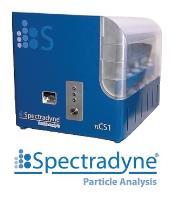 Add My Company
Add My Company
Sign In
nCS1 – Nanoparticle Application Note
14-08-2019

Measurement of All Nanoparticle Material Types
The Spectradyne nCS1 employs a novel implementation of the resistive pulse sensing method to count and size nanoparticles quickly and with high resolution. Sizing precision of ±3% is typically achieved, with measurement rates up to 10,000 particles/s. Because particles are measured electrically in the nCS1, not optically, particles composed of any material can be analysed equally well, without a materials-influenced bias.
Nanoparticles of non-biological origin are used in a broad range of applications. Metal-oxide nanoparticles such as TiO2 are used as additives in cosmetic materials (for example, UV absorbers in sunscreen) and food (e.g., whiteners in frosting). Semiconductor nanoparticles are used for their unique optical properties (as light-emitting quantum dots or in digital displays), and other silicon-derived particles are used in novel battery technologies. Gold nanoparticles are used in a variety of applications including drug delivery and in-vivo targeted treatments.
The nCS1 is able to accurately measure particles of any material composition by virtue of the electrical method it uses for detection. In this application note, the nCS1 accurately measures the size and concentration of 4 different types of nanoparticle. Particles were suspended in PBS + 1% Tween 20, and mixed with control particles having known mean diameter. In each case results are shown with a measurement of the pure control particles (no additional particles) for comparison.
Detection of 4 different nanoparticle materials: Lipid nanoparticles (62 nm, left), iron oxide magnetic nanoparticles (140 nm, centre), and biocomposite (61 nm, right) in addition to polystyrene control particles (left and right 150 nm, centre 288 nm). In the case of the magnetic nanoparticles, the nCS1-measured mean particle diameter agrees within a few percent of the value specified by the manufacturer, which was obtained using TEM, a much costlier and time-intensive method.
These examples demonstrate that the electrical detection method used by Spectradyne’s nCS1 delivers measurement results that are independent of the composition of the particles. Of particular importance are measurements of materials that have similar index of refraction to that of the surrounding medium (e.g., biological nanoparticles such as lipids and virus). These particles are notoriously difficult to characterise using standard methods, because most standard methods ultimately rely on optical scattering or light obscuration, whose sensitivity depend strongly on index contrast.
Spectradyne’s nCS1 provides accurate, high-resolution particle size and concentration distributions for particles of all material types. For more information or to arrange a demonstration of the technology, please contact us.
For more information on nCS1 – Nanoparticle Application Note talk to Meritics Ltd
Enquire Now
More News
List your company on FindTheNeedle.

